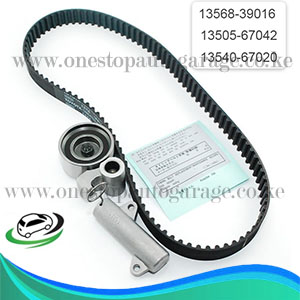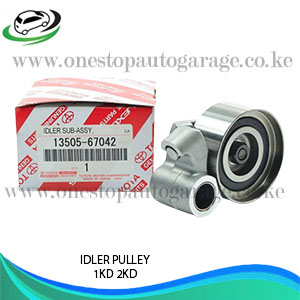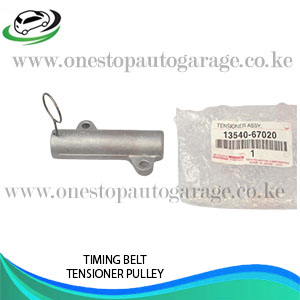-6%
Get Land Cruiser 100/79/75 Tensioner Chain
A tensioner chain, also known as a timing chain tensioner, is a critical component in an engine’s timing system. Its primary function is to maintain proper tension on the timing chain or timing belt, ensuring precise synchronization of the engine’s internal components. Here’s a detailed look into the function, importance, and operation of a tensioner chain:
Function of a Tensioner Chain:
- Maintaining Proper Tension:
- The tensioner chain is designed to keep the timing chain or timing belt tight with the correct amount of tension.
- This tension is crucial for preventing slack or excessive play in the chain/belt, which could lead to timing errors and potential engine damage.
- Ensuring Timing Accuracy:
- By maintaining optimal tension, the tensioner chain helps ensure that the camshaft(s) and crankshaft remain synchronized.
- Proper timing synchronization is critical for the engine’s valves to open and close at the correct times relative to the piston’s position.
- Absorbing Slack:
- Over time, timing chains or belts can stretch or wear, causing slack.
- The tensioner chain compensates for this slack by automatically adjusting tension, thereby maintaining consistent timing and engine performance.
- Noise Reduction:
- It helps reduce noise and vibrations that may occur due to slack in the timing components.
- A properly functioning tensioner chain contributes to quieter engine operation.
- Longevity and Reliability:
- The tensioner chain itself is designed to withstand high levels of mechanical stress and wear.
- It typically includes components such as a hydraulic piston or spring mechanism that adjusts tension automatically over the service life of the chain or belt.
Types of Tensioner Chains:
- Hydraulic Tensioner: Common in modern engines, it uses engine oil pressure to maintain constant tension on the timing chain or belt.
- Spring-Loaded Tensioner: Utilizes a spring mechanism to apply tension. It may be used in conjunction with hydraulic assistance or independently in simpler engine designs.
Signs of Issues with a Tensioner Chain:
-
1. Engine Misalignment or Timing Issues:
- Rough Idling: A noticeable rough or uneven idle, where the engine feels shaky or unstable, can indicate timing chain tensioner problems.
- Engine Hesitation: Delayed or hesitant response to throttle input, especially during acceleration, may suggest timing chain slack affecting engine timing.
- Misfires: Incorrect engine timing can cause misfires, where cylinders do not fire in sequence or at the right time.
2. Audible Signs:
- Rattling or Tapping Noise: A common symptom of a failing tensioner chain is a rattling or tapping noise coming from the engine compartment.
- Cold Start Rattle: This noise may be more noticeable during cold starts and then diminish as the engine warms up.
- Under Load: The noise may also become more pronounced when the engine is under load or at higher RPMs.
3. Check Engine Light (CEL):
- Timing Related Codes: Issues with the timing chain tensioner can trigger specific diagnostic trouble codes (DTCs) related to timing errors or camshaft/crankshaft position sensor discrepancies.
- Check Engine Light: The illumination of the check engine light (CEL) may indicate such timing-related issues.
4. Visible Wear or Damage:
- Inspect the Timing Components: During maintenance or diagnostics, visually inspect the timing chain, tensioner, guides, and associated components.
- Wear or Slack: Look for signs of wear, such as excessive play in the timing chain, visible slack, or wear on the tensioner components.
5. Engine Performance Issues:
- Reduced Power: Timing chain tensioner problems can lead to reduced engine power and efficiency.
- Poor Fuel Economy: Incorrect engine timing can also contribute to decreased fuel efficiency.
6. Overheating and Oil Pressure Issues:
- Engine Overheating: In severe cases, a malfunctioning tensioner chain can cause engine overheating due to incorrect valve timing or inadequate coolant flow.
- Oil Pressure Problems: A failing tensioner chain can affect oil pressure, potentially leading to lubrication issues and engine damage.
7. Diagnostic Challenges:
- Intermittent Issues: Sometimes, symptoms of a failing tensioner chain may be intermittent, making diagnosis more challenging.
- Comprehensive Inspection: A thorough inspection by a qualified technician using diagnostic tools is often necessary to pinpoint timing-related issues accurately.
Maintenance and Replacement:
- Regular Inspection: Include inspection of the tensioner chain and timing components during routine maintenance intervals, especially as recommended by the vehicle manufacturer.
- Replacement: Replace the tensioner chain and associated components (timing chain/belt, guides, etc.) as part of scheduled maintenance or if signs of wear or malfunction are detected.
- Professional Service: Due to the complexity of engine timing systems, particularly in modern vehicles, consider seeking professional assistance for diagnosis and replacement.
Follow us on Facebook For more parts.



